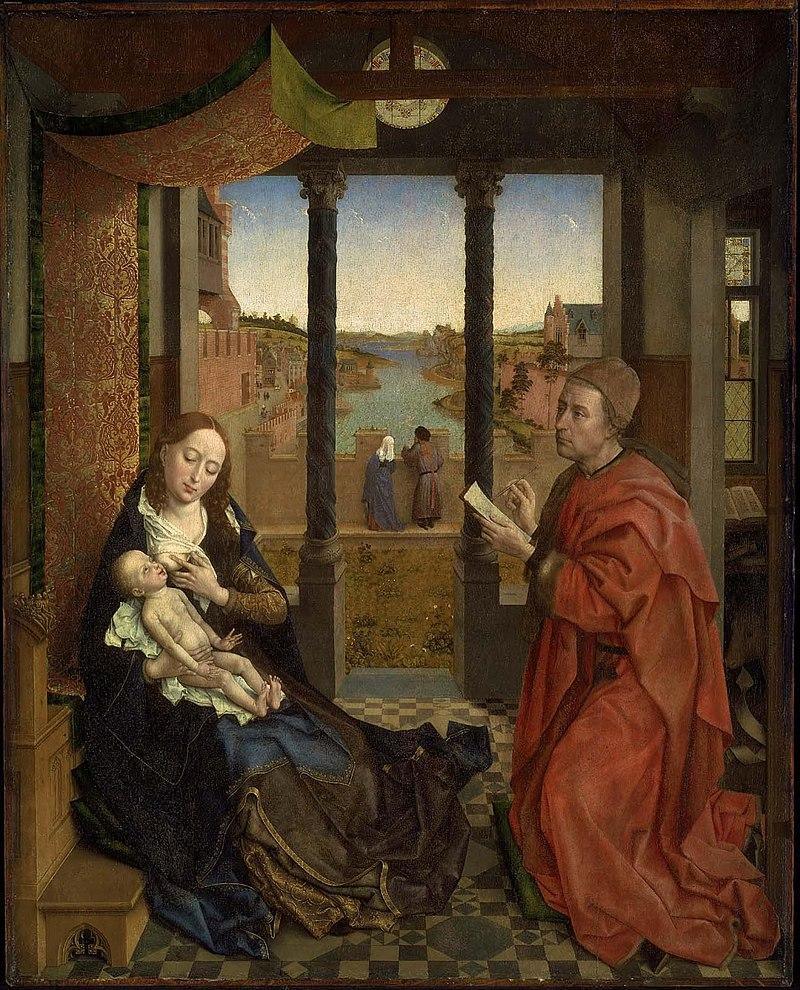Description
This is one of the most important paintings in Northern Europe. In it, Rogier exquisitely combined the Gothic heritage of stylized patterns with a new sense of naturalism. However, he did not simply replicate the world around him, rather the artist manipulated details to create an intricate program of symbols. For example, the enclosed garden in this painting refers to the purity of the Virgin, while the carved figures of Adam and Eve on the arms of the throne symbolize the role of Christ and Mary in redeeming humanity from original sin. Rogier may have modeled the features of Saint Luke on his own.
The theme is taken from a legend of Greek origin from the 6th century, according to which Saint Luke was the first to draw a portrait of the Virgin Mary. The artists saw Lucas as the patron of their art. Rogier van der Weyden put the action in an open loggia. On the left, at the foot of a throne, the Virgin is seated, feeding the Child Jesus. Hinting at her future status as Queen of Heaven, the throne is decorated with sculptural figures of Adam and Eve, indicating that Christ and the Virgin will atone for their original sin. Facing the Virgin, Saint Luke has respectfully knelt as he seeks to capture her appearance. The artist manages to convey both Lucas's trembling reverence and his concentration in his drawing. Behind Saint Luke we can only see a bull and a book, both traditional attributes of the apostle. Two figures contemplating the landscape from the battlements possibly represent Joaquín and Ana, the Virgin's parents.
This painting is supposedly the first he did in that office. The setting is based on the traditional belief that Saint Luke had painted the Virgin Mary and the infant Jesus from life, despite the fact that Lucas was alive long after she and the baby Messiah were gone.
There is more to this painting than meets the eye. For starters, it may not be Saint Luke painting Mary, but Weyden himself. "Lucas", compared to the two figures on the left, is more detailed and realistically painted. Scattered throughout the painting are various symbols with religious significance: the throne behind the Virgin, the human figures on the arm of the throne closest to the viewer, and a bull behind the painter. The first signifies the future state of Mary, the second represents her destiny to free man from the original sin of Adam and Eve, and the third is the personal symbol of Saint Luke. Additionally, X-ray images reveal that Weyden made several revisions just below the finished product, including changes to the position of the hands and to facial expression.
Saint Luke was one of the Four Evangelists, the men credited with writing the Four Gospels that make up the bulk of the New Testament. Of the four books, Luke's interpretation of the life and ministry of Jesus is written with the greatest focus on his divine and otherworldly nature. Thematically, his version of the Gospel focuses primarily on forgiveness and mercy. Only in Luke does the parable of the prodigal son and the washing of the woman's feet appear.
Currently, four versions of the painting Saint Luke drawing the Virgin are known throughout the world. One is in the State Hermitage, the other three are in the Museum of Fine Arts in Boston, USA, the Alte Pinakothek in Munich, Germany, and the Groeningemuseum in Bruges, Belgium. The painting in the Hermitage had been divided into two parts. The right half, depicting Saint Luke, was acquired in 1850 from the collection of King William II of the Netherlands, who had married a daughter of Tsar Paul I, Anna Pavlovna. The left half, with the representation of the Virgin and Child, was purchased in 1884 from the Parisian antique dealer Antoine Baer. It comes from the collection of Queen Elizabeth II of Spain, who lived in exile in France.
This painting has undergone several restorations. In 1854, Feodor Tabuntsov cradled the part depicting Saint Luke (adding wooden braces to the back of the panel to prevent warping). Then in 1867 Alexander Sidorov transferred that same half of the panel to canvas. In 1884, after the acquisition of the other half of the painting, the same restorer transferred it from panel to canvas and rejoined it with the first part.
After the reunion of the two halves of the painting, Saint Luke drawing the Virgin almost recovered its original appearance. Almost -because the upper part of the composition was missing and it had two restoration enlargements- in the upper part of the half with Saint Luke and in the lower part of the half with the Virgin. It is possible to imagine the missing upper part of the painting by comparing it with the other three known versions.

